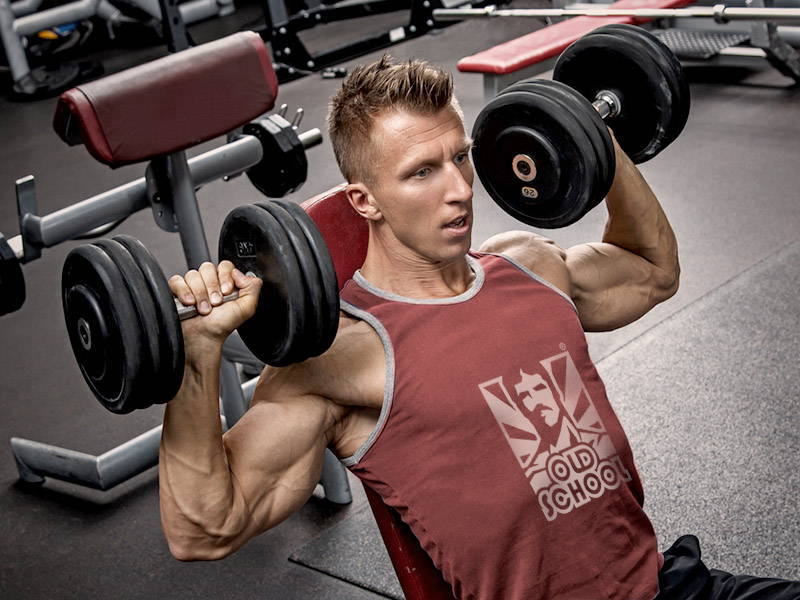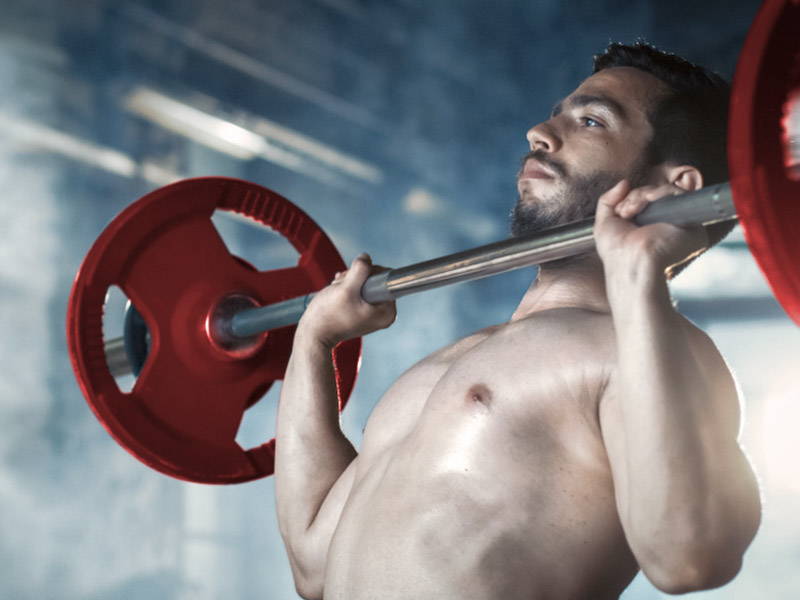
How to Do a Military Press? Standing vs. Dumbbell vs. Seated vs. Barbell
Key Takeaways
- The overhead press is one of the best mass builders for your delts. This compound movement helps increase muscle size and strength, develops your core, and improves your posture.
- The military press is a strict overhead press. This variation requires keeping your heels together and using only your arms and shoulders to lift the weight.
- There are lots of different ways to do a military press. You can perform this movement with a barbell, dumbbells, kettlebells, or resistance bands, from a seated or standing position.
- Seated military presses are gentler on the spine and ensure better support. This makes suitable for those with back pain.
- Avoid this exercise if you have a rotator cuff injury, herniated discs, round back posture, or other back or shoulder problems. Alternate between the military press and other shoulder exercises to keep your muscles guessing and reduce injury risk.
Ask most guys to name the best upper-body exercise for size and strength — and they’ll probably reply “the bench press.” That’s the thinking of modern gym rats.
While it’s true that bench presses build mass and make you stronger, there’s an even better option.
The overhead press was the go-to choice for Arnold Schwarzenegger and other bodybuilding legends back in the Golden Era. This compound movement is a cornerstone in most strength training programs as it hits nearly every muscle in the upper body.

The military press, a strict form of the overhead press, was used as an indicator of strength in the military (hence its name). When done correctly, it targets the deltoids, triceps, legs, and core muscles.
Overhead Press & Beyond
Once you’ve mastered the overhead press, you can move on to more advanced variations, such as the military press, to build strong, broad shoulders. This exercise will not only add size to your frame but also increase upper body strength and help develop your core.
It may also help correct muscular imbalances and increase lockout power.
But what’s the difference between the overhead press and the military press? Is the latter really necessary and how to do it with perfect form? Let’s find out!
Military Press 101: The Best Shoulder Exercise You’re Not Doing
The deltoids are some of the most complex and delicate muscles in the body. Therefore, they’re more prone to injuries resulting from overtraining, overuse, or poor lifting form. Common shoulder injuries, such as rotator cuff tears, bursitis, and strains, can affect your mobility and cause severe pain.

As mentioned earlier, the military press is a strict form of overhead presses. When performing this movement, you’ll bring your feet together and brace your core. As a result, your abdominal muscles have to do more work to keep you stable as you lift the weight.
This movement is considered safer than the conventional overheard press and other deltoid exercises. That doesn’t mean it’s easier, though. It requires a strong core and perfect posture.
Military Press Popularity
So how come the military press isn’t popular these days? Back in the 1920s, it was one of the three weightlifting movements included in the Olympics.
One reason for its fall in popularity is that it was eliminated from the 1972 Summer Olympics. The rise of powerlifting had a role too because athletes who compete in this sport prefer the bench press over military presses.

However, the military press is by no means inferior to the bench press or conventional overhead press. On the contrary — it provides a full-body workout and has incredible carryover to other exercises. It’s one of the best movements for the anterior and lateral delts, but it also targets the posterior delts.
Over the years, all bodybuilding legends, from Arnold and “Reg” Park to Eugen Sandow, used the military press. Furthermore, this compound lift has served as a strength test in the military. When done right, it produces a smooth, efficient range of motion that promotes shoulder health and improves your posture.
Due to its strict form, it’s difficult to injure your shoulders with this exercise. However, you do need to pay attention to your lifting form. And that’s what we’ll discuss today.
Muscles Used in a Military Press
First things first, let’s see how the military press benefits your physique. Different variations of this movement target different muscles.
The barbell standing military press, for instance, targets your anterior delts, or front shoulders, but it also involves the pecs, triceps, lateral delts, traps, and biceps.

The barbell seated military press, by comparison, hits your front shoulders too, but it engages the triceps, biceps, and traps to a different extent than the standing version.
Regardless of what variation you choose, the primary muscles worked are the anterior delts. The lateral deltoids act as synergists. You will also use your triceps to lift the weight and extend your elbows, so these muscles will get a great workout too.
In fact, overhead presses — including the military press — are ideal for triceps development, reports the Journal of Strength and Conditioning Research. With this movement, you can build stronger pecs and triceps, which in turn, will increase your bench press.

The military press is a fantastic move for your abs too. These muscles work hard to help you stabilize the weight, which increases their stability and strength.
Except for your quads, hamstrings, and calves, this compound lift involves most muscles to some extent. Include in it your shoulder training routine to build massive delts, epic core strength, and bigger traps.
Military Press vs. Conventional Overhead Press
Do a quick search online for “military press,” and you’ll find thousands of posts and training videos mentioning the “shoulder press” and “overhead press.” Do they all mean the same thing?
Yes and no.
Think of the overhead press or shoulder press as an umbrella term for military presses, Arnold presses, Olympic presses, and other similar exercises. They all are variations of the same movement.

The military press is just an overhead press that requires keeping your heels together with strict form. Your torso and hips must stay still as you lift the barbell. Basically, you can only move your arms and shoulders, which forces you to use your core for balance and stability.
A conventional overhead press, by contrast, requires a wider stance and allows you to move your hips to some extent.
Just like the overhead press, military presses can be performed in various ways. Depending on your preferences, you can use a barbell or dumbbells, kettlebells, or resistance bands. Furthermore, you may execute the movement from a seated or standing position.
And this brings us to the next point.
Best Military Press Variations for Mind-Blowing Gains
As you probably know, progressive overload is the foundation of strength training. Hypertrophy occurs in response to the training stimulus, but it slows down or plateaus as your body adapts to exercise.
The only way to make further gains is to keep your muscles guessing. This can be done by gradually increasing the amount of weight or the number of reps, your workout volume, or training frequency. Another strategy is to decrease the rest time between sets.
Keeping your workouts varied matters too. If you do the same exercises in the same order over and over again, you’ll hit a plateau.

Take the military press, for instance. This movement is typically performed from a standing position, but you can also sit on a flat bench. Or you can replace the barbell with dumbbells to have more control over the weight used.
With this approach, you’ll hit your muscles from different angles and challenge them into growth. Plus, you will find easier to overcome plateaus.
Military Press Variations
Consider these variations of the military press:
- Seated barbell military press
- Seated dumbbell military press
- Arnold military press
- Smith machine military press
- Standing barbell military press
- Standing dumbbell military press
- One-arm seated kettlebell military press
- Two-arm kettlebell military press
The Arnold military press, for example, was named after bodybuilding legend Arnold Schwarzenegger. You’ll need a set of dumbbells to perform this movement. Do it from a standing or seated position.
Unlike the standard military press, this exercise requires twisting at the wrist when lowering the dumbbells back to the starting position. It allows for a wider range of motion but limits the amount of weight you can use.
The Arnold press and other variations, though, are not military presses in the strict sense of the word. But they have their role in your workout plan and can take your gains to a whole new level.
How to Do a Military Press the Right Way
Now that you know more about the military press, it’s time to learn how to do it properly. We’ll show you the exact steps needed to perform a barbell military press with perfect form.
Let’s get into it!
- Rack the barbell 1-2 inches below its position when you’re standing tall.
- Grasp it with an overhand grip (palms facing forward). Place your hands on the bar about shoulder-width apart. Keep your tight and rigid at all times.
- Position the bar on your front shoulders, pushing your elbows in toward your body.
- Take two steps back and brace your core. Keep your heels together and squeeze your glutes.
- Raise the barbell over your head until your arms are extended. Hold it for a second at the top. Make sure your elbows are pointing forward.
- Slowly bring the bar to your chin or upper chest. Keep your abs squeezed throughout the movement. Repeat.
For best results, alternate the military press with other shoulder exercises. This movement places a lot of strain on the lower back and shoulder joints, so it’s OK to replace it with a similar exercise once in a while.

The seated overhead press, the Arnold press, and dumbbell shoulder presses are all a good choice. For example, if you’re training your delts twice a week, use the standing military press during session #1 and the seated dumbbell press during session #2.
Military Press Tips
The military press is quite simple at first sight. All you need to do is to push the barbell overhead in a straight line. But like with most things, it’s all in the small details.

Follow these rules to stay injury-free and get the most out of your overhead press:
- Start at a lower weight than you think you’re ready for.
- Use a slow, controlled motion throughout the entire movement. Don’t just rush through the reps.
- Keep your wrists straight, even if the grip is less comfortable. Bending them may increase injury risk and reduce how much force you can generate.
- Maintain a full range of motion.
- Avoid common mistakes, such as flaring your elbows or arching your back. Maintain a neutral spine.
- Keep your elbows close to your body and your chest up.
- Make sure the barbell is directly above your feet at all times.
- Do not bend your knees or use your legs to generate force. If you do so, that’s a push press.
- Squeeze your glutes and core muscles to maintain proper posture.
- Slightly contract your shoulders to feel the burn. This will also make it easier to drive your arms up and finish the movement with perfect form.
- Inhale before you start the lift to stabilize your shoulder blades and torso. Exhale as you lift the barbell and inhale as you lower it.
As a rule of thumb, keep your back straight and your pelvis right under your torso. Brace your core muscles for support.
If you have low back pain, switch to the seated military press. This variation is safer for your spine and ensures better support. Avoid the behind-the-neck press, especially if you have shoulder issues.
Beware that military shoulder presses — and overhead presses, in general — may not be safe for everyone.
Despite their efficacy, these shoulder exercises are not recommended to those with anterior scapular tilting, rotator cuff injuries, labrum injuries, round back posture, and herniated discs.
These Military Press Mistakes Are Killing Your Gains
As you see, there’s a lot that goes into performing a military press correctly. Frequent mistakes, such as using a partial range of motion and not locking out the weight, may result in injuries and kill your gains.
A common mistake is using too much weight. Since the military press seems easy, many folks assume they’re capable of lifting hundreds of pounds. Unfortunately, this often leads to shoulder or back pain and injuries.

As mentioned above, it’s recommended to start with a lighter load and increase it as you get stronger. Try to find a weight that allows you to complete about three sets of eight reps with perfect form.
Common Mistakes
Another frequent problem is arching the back. If you do so, you’ll place strain on your lower back, which may result in pain and herniated discs. On top of that, your shoulder blades will be in a poor position that comprises the movement.
Many gym-goers fail to lock out their elbows at top of the movement. This affects their stability and may cause injuries to the shoulder and elbow joints. That’s why it’s important to fully extend your arms and hold the contraction.
Gripping too wide or too close may compromise your lifting form too. The bigger you are, the wider your grip should be. If your grip is too narrow, you’ll end up touching your shoulders with your hands.
Also, don’t neglect your glutes. Keep them squeezed throughout the movement to generate force and push the bar with good form. If these muscles are loose, your lower back will move into a bowed position, which may lead to injuries.
Similarly, contract your core for stability and balance. By doing so, you’ll create a strong base as you lift the bar and ensure proper back positioning.
Get the Most Out of Your Shoulder Workout
The military press is just a small part of your workout. It’s your overall training routine that matters most. Overhead presses alone won’t help you add size to your delts.

For inspiration, check out the best deltoid workouts and exercises using machines. We’ll show you how to do the cable shoulder press, Smith machine upright rows, front cable raises, and other movements for massive shoulders.
If you’re trying to improve your overall strength and conditioning, full-body workouts are your best bet. Incorporate the military press into your routine to pack on mass and build a strong core.
What’s your take on the military press? When was the last time you did this exercise? Share your experience below!








